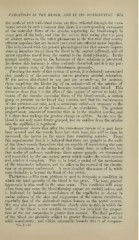Page 663 - My FlipBook
P. 663
VARIATIONS IN THE BLOOD, AND IN ITS DISTRIBUTION. 673
the needs of each individual tissue are thus reflected through the vaso-
motor nerves in such a manner that tliere is a corresponding movement
of the muscular fibres of the arteries regulating the blood-supply in
every part of the body, and that the nerves thus acting play the part
of sensory nerves in the reflex phenomena in the fact that they convey
afferent impulses that are in turn converted into efferent motor impulses.
This is in accord with the general physiojogical law that sensory inipres-
sions or impulses travel from the distal to the central (afferent), and all
motor impulses travel from the central to the distal (efferent). In the
normal healthy organism the harmony of these relations is preserved.
In disease this harmony is often seriously disturbed, and it is my pur-
pose to notice some of these disturbances presently.
Pursuing the study of this system of nerves, it is definitely ascertained
that paralysis of the vaso-motor nerves produces arterial relaxation.
If the nerves distributed to any part are severed—as, for instance,
those supplying the hinder leg of an animal—all of the arteries of
that member dilate and the leg becomes surcharged with blood. This
seems to show that it is the office of this system of nerves to hold, by
means of the circular muscular fibres of the blood-vessels, a certain
grasp or pressure on the blood they contain, and that the maintenance
of this pressure—or tone, as it is sometimes called—is necessary to the
proper performance of the functions of the circulation. The greatest
proportionate amount of muscular fibre is in the smallest arteries, and
it is these that undergo the greatest change in calibre. In this way the
blood is not only more firmly grasped, but its outflow from the arteries
into the capillaries is regulated.
Experiment shows that after the vaso-motor nerves of a part have
been severed and the vessels have lost their tone, this will in time be
recovered, the nerves in the mean time remaining asunder. From,
this experimental fact it is inferred that there are ganglia in the walls,
of the blood-vessels themselves that are capable of maintaining the tone
of the circulation in the absence of the central force or influence, but
that under all ordinary conditions these minor ganglia are dominated!
and controlled by the one central power which unifies the whole system,
and renders it complete. This is, in brief, a recital of the mechanism
of the vaso-motor influence, and its office in the control of the circula-
tion as at present understood. A more detailed discussion of it, while
very desirable, is beyond the limit of this article.
Plethora.—The term plethora is used to designate a condition in
which the total quantity of the blood is too great. The term general
hypercemia is also used in the same sense. This condition will occur
when from any cause the blood-forming organs are unduly active, and
is indicated by habitual over-fulness of the capillaries as shown in
undue redness of the skin and turgescence of the venous circulation,
especially that of the abdominal region known as the portal svstem.
AVe may also have another condition closely akin to this, in which the
bulk of the blood is not notably increased, but in which the propor-
tion of the red corpuscles is greater than normal. The fluid portions
of the blood are probably subject to greater fluctuations than are its
solid constituents ; and within reasonable bounds this is of compara-
VoL. I.—43


